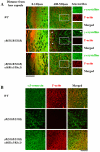Connexin mediated cataract prevention in mice
- PMID: 20844585
- PMCID: PMC2936561
- DOI: 10.1371/journal.pone.0012624
Connexin mediated cataract prevention in mice
Abstract
Cataracts, named for any opacity in the ocular lens, remain the leading cause of vision loss in the world. Non-surgical methods for cataract prevention are still elusive. We have genetically tested whether enhanced lens gap junction communication, provided by increased α3 connexin (Cx46) proteins expressed from α8(Kiα3) knock-in alleles in Gja8tm1(Gja3)Tww mice, could prevent nuclear cataracts caused by the γB-crystallin S11R mutation in CrygbS11R/S11R mice. Remarkably, homozygous knock-in α8(Kiα3/Kiα3) mice fully prevented nuclear cataracts, while single knock-in α8(Kiα3/-) allele mice showed variable suppression of nuclear opacities in CrygbS11R/S11R mutant mice. Cataract prevention was correlated with the suppression of many pathological processes, including crystallin degradation and fiber cell degeneration, as well as preservation of normal calcium levels and stable actin filaments in the lens. This work demonstrates that enhanced intercellular gap junction communication can effectively prevent or delay nuclear cataract formation and suggests that small metabolites transported through gap junction channels protect the stability of crystallin proteins and the cytoskeletal structures in the lens core. Thus, the use of an array of small molecules to promote lens homeostasis may become a feasible non-surgical approach for nuclear cataract prevention in the future.
Conflict of interest statement
Figures





Similar articles
-
Knock-in of alpha3 connexin prevents severe cataracts caused by an alpha8 point mutation.J Cell Sci. 2006 May 15;119(Pt 10):2138-44. doi: 10.1242/jcs.02940. J Cell Sci. 2006. PMID: 16687738
-
Absence of alpha3 (Cx46) and alpha8 (Cx50) connexins leads to cataracts by affecting lens inner fiber cells.Exp Eye Res. 2006 Sep;83(3):688-96. doi: 10.1016/j.exer.2006.03.013. Epub 2006 May 11. Exp Eye Res. 2006. PMID: 16696970
-
Dense nuclear cataract caused by the gammaB-crystallin S11R point mutation.Invest Ophthalmol Vis Sci. 2008 Jan;49(1):304-9. doi: 10.1167/iovs.07-0942. Invest Ophthalmol Vis Sci. 2008. PMID: 18172107
-
Connexins in lens development and cataractogenesis.J Membr Biol. 2007 Aug;218(1-3):9-12. doi: 10.1007/s00232-007-9033-0. Epub 2007 Jun 20. J Membr Biol. 2007. PMID: 17578632 Review.
-
Gap junctions or hemichannel-dependent and independent roles of connexins in cataractogenesis and lens development.Curr Mol Med. 2010 Dec;10(9):851-63. doi: 10.2174/156652410793937750. Curr Mol Med. 2010. PMID: 21091421 Free PMC article. Review.
Cited by
-
Role of Aquaporin 0 in lens biomechanics.Biochem Biophys Res Commun. 2015 Jul 10;462(4):339-45. doi: 10.1016/j.bbrc.2015.04.138. Epub 2015 May 8. Biochem Biophys Res Commun. 2015. PMID: 25960294 Free PMC article.
-
Mutation screening and genotype phenotype correlation of α-crystallin, γ-crystallin and GJA8 gene in congenital cataract.Mol Vis. 2011 Mar 11;17:693-707. Mol Vis. 2011. PMID: 21423869 Free PMC article.
-
Connexin Mutants Compromise the Lens Circulation and Cause Cataracts through Biomineralization.Int J Mol Sci. 2020 Aug 13;21(16):5822. doi: 10.3390/ijms21165822. Int J Mol Sci. 2020. PMID: 32823750 Free PMC article. Review.
-
Connexin Mutants Cause Cataracts Through Deposition of Apatite.Front Cell Dev Biol. 2022 Jul 22;10:951231. doi: 10.3389/fcell.2022.951231. eCollection 2022. Front Cell Dev Biol. 2022. PMID: 35938173 Free PMC article.
-
Oxidation of active cysteines mediates protein aggregation of S10R, the cataract-associated mutant of mouse GammaB-crystallin.Proteins. 2022 Nov;90(11):1987-2000. doi: 10.1002/prot.26391. Epub 2022 Jul 7. Proteins. 2022. PMID: 35726360 Free PMC article.
References
-
- Asbell PA, Dualan I, Mindel J, Brocks D, Ahmad M, et al. Age-related cataract. Lancet. 2005;365:599–609. - PubMed
-
- Bloemendal H, de Jong W, Jaenicke R, Lubsen NH, Slingsby C, et al. Ageing and vision: structure, stability and function of lens crystallins. Prog Biophys Mol Biol. 2004;86:407–485. - PubMed
-
- Kuszak JR, Zoltoski RK, Sivertson C. Fibre cell organization in crystalline lenses. Exp Eye Res. 2004;78:673–687. - PubMed
Publication types
MeSH terms
Substances
Grants and funding
LinkOut - more resources
Full Text Sources
Medical
Molecular Biology Databases
Miscellaneous

